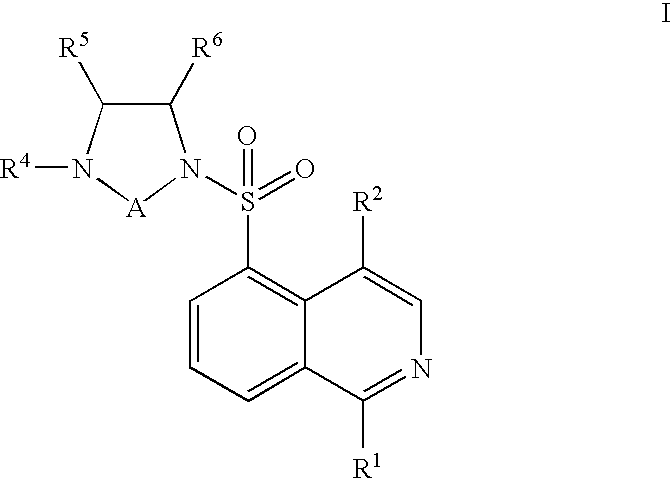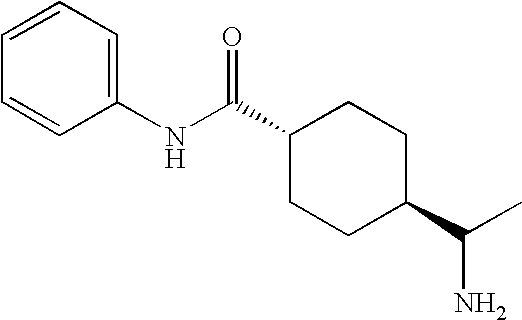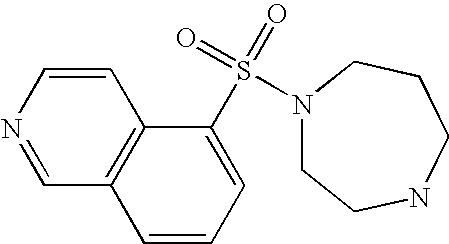Use of Rho kinase inhibitors in the treatment of hearing loss, tinnitus and improving body balance
- Summary
- Abstract
- Description
- Claims
- Application Information
AI Technical Summary
Benefits of technology
Problems solved by technology
Method used
Image
Examples
example 1
In Vitro Assays for Determination of Rho Kinase Activity and Inhibition Thereof
[0041] Rho kinase activity and inhibition of activity by test compounds in vitro is carried out using a radioactive assay or a fluorescence polarization assay as described herein.
[0042] Human recombinant Rho kinase (ROKα / ROCK-II, (aa 11-552), human active, catalog #14-451, Upstate Biotechnology Co., Lake Placid, N.Y.), MgCl2 / ATP cocktail, and enzyme substrate (Upstate) are used in the present assay. The enzyme assays are performed using a Biomek 2000 Robotic Workstation (Beckman Instruments, Palo Alto, Calif.) in a 96-well format using [γ-33P]-ATP (Perkin-Elmer Life Sciences, Boston, Mass.). Stock [γ-33P] ATP (3000 Ci / mmol) is diluted to 1 μCi / μl with the MgCl2 / ATP cocktail solution. The concentrations of MgCl2 / ATP used are 15 mM and 100 μM, respectively. The ROKα / ROCK-II (human, active, 1 ng per well) is assayed using the Long S6 substrate peptide (30 μM, Upstate). The substrate and enzyme are diluted ...
example 2
Agents for Promoting Otic Sensory Neuroepithelial Cell and / or Spiral Ganglion Neuron Proliferation
[0045] Spiral ganglion neurons (SGNS) are primary auditory afferent cells that deliver signals from the auditory receptors, the hair cells in the organ of Corti in the cochlea, to the brain through the cochlear nerve. Damage or loss of either the SGNs or the hair cells can affect the auditory pathway and result in hearing loss. Rho kinase inhibitor agents are anticipated to promote inner ear hair cell and SGN proliferation and thus would be useful for helping replace damaged or lost cells as in various otic disorders described above. SGN and sensory neuroepithelial hair cells and their progenator cells derived from inner ear cochlear tissues from rat, human and other mammalian species can be cultured in vitro as described in various articles and patents (e.g. U.S. Pat. No. 6,653,279; Corwin et al. Ann. Rev. Neurosci. 14: 301-333, (1991); Warchol et al. Science 259: 1619-1622, (1993); Z...
example 3
Agents for Rescuing and / or Protecting Otic Sensory Neuroepithelial Cell and / or Spiral Ganglion Neurons
[0046] Rho kinase inhibitor agents are anticipated to protect SGN and inner ear sensory neuroepithelial cells from cytotoxic (ototoxic in particular) agents, exposure to cocaine, ischemia, hypoxia and / or aglycemia, growth factor withdrawal, laser bums or other acute or protracted insult(s) or various combinations thereof. The inner ear cells isolated and cultured in vitro as described in Example 1 can be exposed to ototoxic drugs (e.g. aspirin, aminoglycoside antibiotics, quinines, cisplatin), or high glutamate concentrations, trophic factor (serum or specific growth factors) withdrawal, or hypoxic / aglycemic conditions (e.g. Ohia et al. Curr Eye Res. 23: 386-392, (2001); J. Ocular Pharmacology & Therapeutics 19: 599-609, (2003)), oxidative stress, or laser microbeam irradiation in the absence or presence of Rho kinase inhbitor agent(s) at various concentrations to assess the cytopr...
PUM
| Property | Measurement | Unit |
|---|---|---|
| Inhibition | aaaaa | aaaaa |
Abstract
Description
Claims
Application Information
 Login to View More
Login to View More - R&D Engineer
- R&D Manager
- IP Professional
- Industry Leading Data Capabilities
- Powerful AI technology
- Patent DNA Extraction
Browse by: Latest US Patents, China's latest patents, Technical Efficacy Thesaurus, Application Domain, Technology Topic, Popular Technical Reports.
© 2024 PatSnap. All rights reserved.Legal|Privacy policy|Modern Slavery Act Transparency Statement|Sitemap|About US| Contact US: help@patsnap.com










